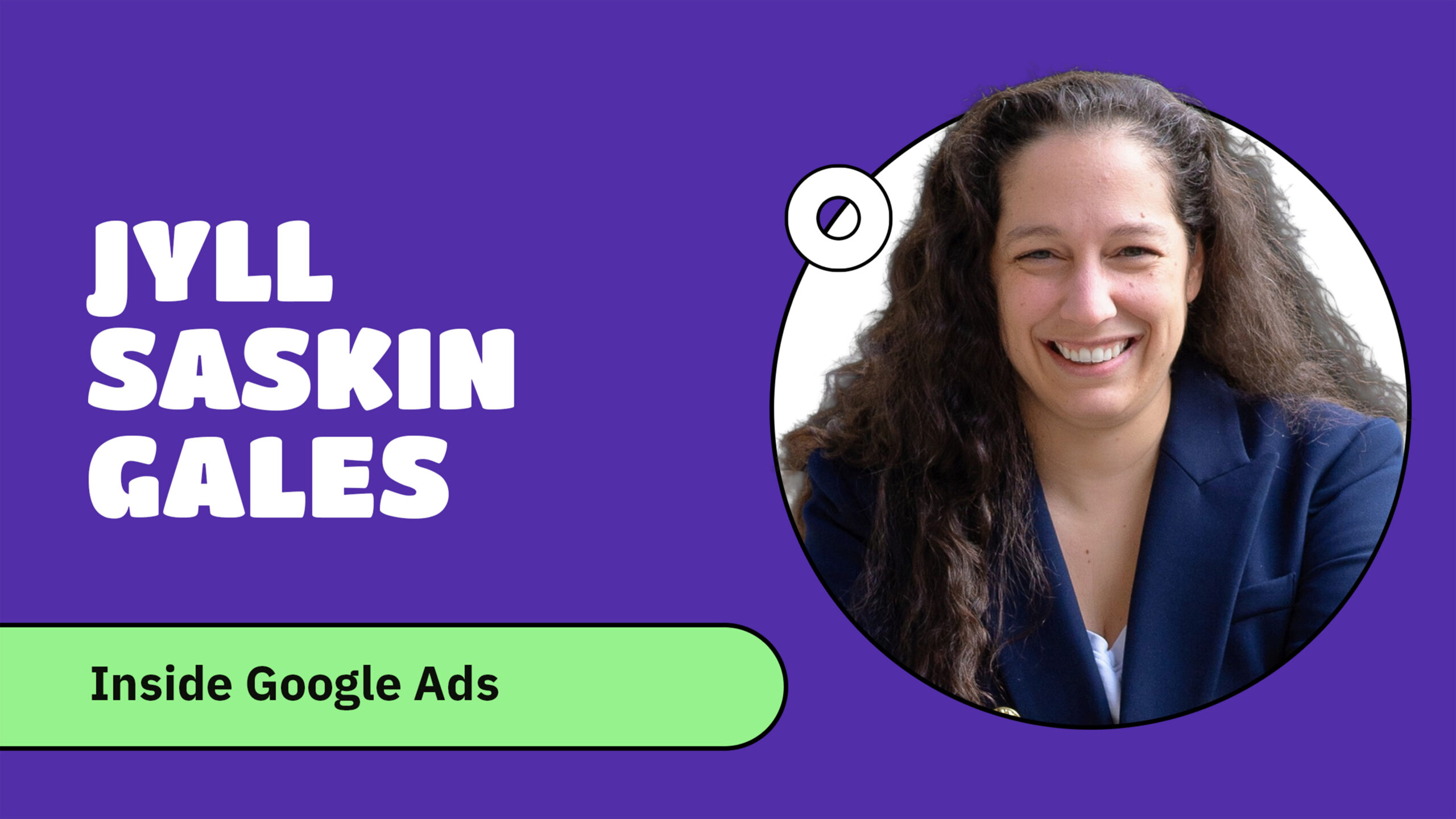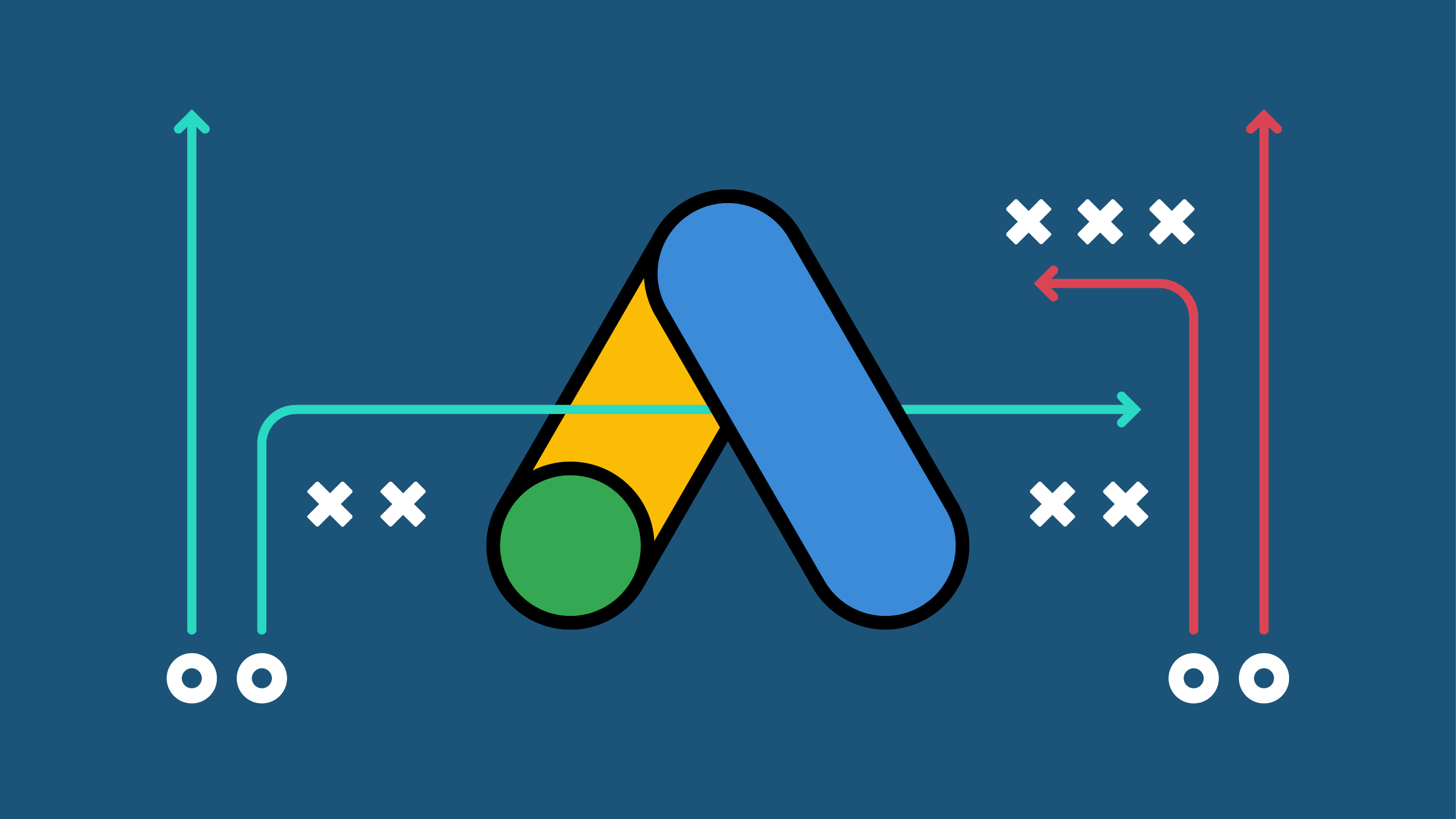I’ll be honest – I haven’t been hands-on in Google Ads for a very long time. I go in there to configure conversions and help clients understand their measurement, but the day-to-day campaign management? That’s never really been my world.
Which is exactly why I was so excited to have Jyll Saskin Gales join me for a webinar on Google Ads targeting strategies for 2025.
I wanted to have Jyll on a webinar because when we bring on new Google Ads management clients at Kick Point, we often hear that they were ready for a change because their Google Ads targeting doesn’t seem to be working anymore or they’re seeing performance drop off for reasons they can’t quite pin down. And honestly, I get it. The landscape has changed so dramatically in the last few years that agencies and experienced advertisers are struggling to keep up.
Between AI automation, restricted targeting options, and constantly changing audience capabilities, it’s tough to know what actually works. That’s why Jyll was the perfect guest. She’s literally written the book on Google Ads audience targeting (Inside Google Ads: Everything You Need to Know About Audience Targeting) and she walked us through what we need to know right now.
In our conversation, Jyll covered 15 different strategies, including four that she said would be new even to experienced Google Ads practitioners. I’m going to share what stood out to me most, but I strongly encourage you to watch the full replay because Jyll goes into much more tactical depth than I can cover here.
Watch The Replay
What Is Google Ads Audience Targeting?
Google Ads audience targeting is how you reach specific groups of people based on their characteristics, interests, and behaviors rather than solely on keyword searches.
Unlike traditional keyword targeting which focuses on what people search, audience targeting considers who they are and what they’re interested in across Google’s properties like YouTube, Gmail, and Discover.
Why Google Ads Audience Targeting Changed (And What It Means for You)
Back in ye olden days of Google Ads, there was much more control over targeting. You could layer audiences, set exact match keywords (that were actually exact), and see exactly who was seeing your ads.
Now? Google’s push toward automation with Performance Max, broad match keywords, and Smart Bidding has fundamentally changed how targeting works. As a result, advertisers feel that they have less control over how you can target your ads.
But Jyll’s perspective really shifted how I think about this. Instead of fighting the automation, she showed us creative ways to work within it. Let’s look at the four core strategies she covered that I found most valuable.
Four Core Targeting Strategies for Automated Google Ads Campaigns
Non-Brand Conquesting: Targeting Competitors Without Bidding on Names
I thought this tactic was really interesting! You’re likely familiar with basic competitor conquesting – you know, bidding on your competitor’s brand name like “Adidas” when you’re Nike. But Jyll introduced something she calls “non-brand conquesting”.
Here’s how most people think about competitor targeting:
Level 1: Search conquesting – You put “Adidas” as a keyword in your search campaign. When people search for Adidas, you show Nike ads. It’s simple, but your click-through rate is usually terrible because people aren’t actually searching for you. Google notices this and dings your Quality Score, which means you pay more for the privilege of showing less relevant ads.
Level 2: Custom segments with competitor brands – Instead of showing ads at the exact moment someone searches for your competitor, you create a custom segment of people who have searched for competitor terms at some point. Then you show them ads while they’re doing other things online – watching YouTube videos, checking Gmail, browsing websites. This tends to work better.
But here’s where Jyll’s “non-brand conquesting” comes in:
Level 3: Non-brand conquesting – Use Google’s Keyword Planner (which is free, by the way) to analyze your competitor’s website. Google will show you what non-brand keywords it associates with that site. So instead of targeting “Adidas,” you might target “running shoes” or “athletic wear” – keywords where your competitor is likely showing up organically or in paid results.
What I really liked about this approach is that you get better click-through rates because people are actually looking for what you offer. And you’re showing up right where your competitors are, without the obvious brand bidding that gets expensive. For more details on the legal and strategic considerations of competitor keyword bidding, check out our guide on competitor brand names in Google Ads.
This takes some work, but here’s the basic process: In Keyword Planner, instead of entering your own website or keywords, you enter your competitor’s URL. Google analyzes their site and suggests keywords it thinks are relevant. Then you use those keywords in your own campaigns.
Audience Layering in Search and Shopping
I usually think about search campaigns as all about keywords. But here’s where I found Jyll’s three-level framework really helpful for thinking about how audiences can improve search performance.
Level 1: Observation Mode
This is where you start gathering data without changing how your ads show. Let’s look at how this works:
You add audiences to your campaign on “observation” (not “targeting”), which means your ads still show the same way they always do. But if the person searching matches one of your audiences, Google makes a note of that.
After some time – usually a few weeks or months depending on your budget – you can see how people who match your audiences perform differently from people who don’t.
Here are three things Jyll recommended that I found helpful:
- Don’t observe too many audiences at once. If you try to observe too many audiences you won’t end up with any usable insights. Stick to 5-10 audiences.
- Observe both what you think will work AND what you think won’t. For example, if you’re a home services business and you know homeowners are your target, also observe renters. I’ll explain why this matters in a minute.
- Check the Insights tab. Here’s something I didn’t know until this webinar: Google now surfaces audience insights automatically, even if you haven’t added audiences on observation. Just go to Campaigns > Insights and Reports > Insights, and Google will show you which audience segments are over-performing in your campaign.
Level 2: RLSA (Remarketing Lists for Search Ads)
This is where you only show an ad if someone is both searching for your keywords AND they’re on your remarketing list.
Jyll used her own business as an example, and shared some real numbers which I always appreciate! In the US market, “Google Ads course” keywords cost about $20 per click. For her business model, that’s just not viable for cold traffic. But if someone has already visited her website or watched her YouTube videos? Then that $20 CPC might be worth it because they’re much more likely to convert.
Now, there’s something important I need to mention here. This strategy requires at least 1,000 users in your remarketing list for it to activate. If you’re a smaller business that doesn’t have that kind of traffic yet, you might not be able to use RLSA effectively. The good news? Jyll introduced us to something called the Google Engaged audience (which I’ll cover in the tips section) that doesn’t have any minimum requirements.
Level 3: Audience Exclusions
Remember when I said to observe audiences you think won’t work? Here’s where that pays off. Sometimes it’s easier and more effective to exclude the people you don’t want rather than trying to figure out the perfect people you do want.
Jyll used a plumber example: If you’re offering emergency plumbing services, you know that renters don’t pay for plumbers – homeowners do. So you could exclude renters from your search campaigns. If someone searches for “plumber near me” but Google knows they’re a renter, you don’t show an ad. If they’re a homeowner or Google doesn’t know, you do show the ad.
Another important point: You can now exclude audiences from Shopping campaigns, not just Search. Google didn’t announce this – Jyll just noticed it appearing in accounts about a month ago. This is exactly why following experts is so important, because these kinds of undocumented changes happen all the time.
Creative Solutions for Restricted Audience Targeting
This was fascinating to me because not every client has a box that they can tick to target their audience. Instead, you need to think creatively, and Jyll walked us through a specific example for one of her clients.
She had a client delivering authentic Indian food in Toronto who wanted to reach people in the Indian diaspora. You can’t tick a box for “Indian descent”. So what do you do?
Level 1: Keywords
This is the obvious starting point: Indian food delivery, authentic Indian food, etc. But the conversion rate was just okay because they were reaching too many people outside their target audience.
Level 2: Custom Segments with Websites and Apps
Jyll did some research: What are the top news sources in India? What are the top Hindi language apps? She found apps like Meesho, PhonePe, Ludoking, and Flipkart. Then she created a custom segment targeting people who use these apps in Toronto.
Level 3: Non-Linear Targeting
This is what Jyll calls taking a “360-degree view” of your target audience, by determining what combination of factors makes this audience unique:
- Affinity audience: Fans of South Asian film
- Affinity audience: Cricket enthusiasts
- In-market audience: Trips to specific Indian cities, especially less well-known cities like Ahmedabad
For my B2B folks – and I see a lot of you in my analytics course – this works for professional targeting too. Maybe you’re trying to reach HR professionals, but there’s no “HR professionals” box to tick. So you think about: What conferences do HR professionals attend? What websites do they visit? You create custom segments with those websites and suddenly you’re reaching your audience without directly targeting a job title Google won’t let you use.
What to Do with Expensive Keywords
This was particularly relevant to me because I often have these conversations with clients in expensive niches – legal services, B2B software – where CPCs are far too expensive to make advertising worthwhile.
Level 1: Exact Match Keywords
Google’s definition of “exact” is not what you’d expect. If you haven’t used Google Ads in a while, you might think exact match means the search has to exactly match your keyword. Not anymore.
Google considers searches with the same “intent or meaning” to be close variants. This includes competitor names. So if you have “Adidas” as an exact match keyword, someone searching for “Nike” might trigger it because Google thinks the intent is similar.
Level 2: Custom Segments for Expensive Searches
Instead of bidding on expensive keywords in the moment when people search for them, you create a custom segment of people who have recently searched for those keywords. Then you show ads to them while they’re doing other things – watching YouTube, checking Gmail, browsing.
Here’s an important technical note Jyll mentioned: If you’re building a custom segment based on searches people have done, this only works effectively when your ads show on Google-owned properties like YouTube, Gmail, and Discover. If you’re showing ads across the broader Display Network on third-party websites, Google can’t reliably match those users to their search behavior due to privacy restrictions and cookie limitations.
Level 3: Adjacent Audiences
Here’s a mattress example Jyll used. There’s an in-market audience for mattresses. Great. But you know who else has ticked that box? Every single mattress competitor.
So what if you targeted people in-market for beds and bed frames instead? Or bedding? Or moving services? These are adjacent audiences – people who aren’t being bombarded by mattress ads yet, but they’re probably going to need a mattress soon.
For B2B, maybe you sell accounting software. Instead of fighting with every competitor for people in-market for accounting software, you might target people in-market for CRM software, or business financial services, or commercial properties for rent. The idea is to reach your audience before they’re in the throes of competitive comparison.
Four Tips to Make These Strategies Actually Work
Tip 1: Know Your Audiences Before You Can Use Them
Here’s where to find all your audience options: Tools > Shared Library > Audience Manager > Choose the “Audiences” tab. Browse the options — you might be surprised by how specific some of them are, like “homeschooling parents” or “cricket enthusiasts”.
The four main categories of Google’s audiences are:
- Detailed demographics (age, gender, parental status, household income, education, homeownership, employment)
- Affinity segments (long-term interests and hobbies)
- In-market segments (people actively shopping for products or services)
- Life events (recent life changes like moving, getting married, graduating)
Jyll mentioned that these audiences change frequently without announcement. So it’s worth browsing periodically to see what’s new.
Tip 2: Turn Content Targeting Into Audience Targeting
Content targeting means showing ads in certain places – on specific websites, apps, or YouTube channels, or for certain keywords. Audience targeting means showing ads to certain people, regardless of where they are.
Custom segments are the bridge between these two approaches:
- Keywords (content) → People who searched for terms that match your keywords (audience)
- Topics (content) → People interested in those topics (audience)
- Websites/apps (content) → People who visit websites similar to those websites/apps (audience)
Custom segments let you maintain targeting precision even as placement and topic targeting options decline.
Tip 3: Spy on Targeting Every Day
Use the YouTube homepage as your training ground. Every time you see an ad on YouTube, click the three dots and select “Why you’re seeing this ad.” Before you look, try to guess why Google targeted you with that ad. Then check if you’re right.
You’ll learn what advertisers are doing — who is layering audiences, using custom segments, or just spraying and praying. It’s free education every time you use YouTube.
Tip 4: Let Your Creative Lead Your Targeting
In automated campaigns like Performance Max and Demand Gen, Google’s algorithms look for people who engage with your ads and find more people like them. If your creative is boring or generic, the engagement signals are weak. If your creative is compelling, those signals are strong and Google finds you more of the right people.
Instead of “New arrivals” or “Shop now,” try communicating one specific benefit or whatever makes you different. You don’t need to be clever — you can just be specific and helpful.
Why This Matters for Analytics and Measurement
Understanding how targeting works doesn’t just help you run better ads — it helps you interpret your analytics data correctly.
Here’s what I often see: The PPC team and the analytics team aren’t communicating about attribution. The PPC team is using custom segments to target people who’ve searched for specific keywords, but then those people convert through organic search two weeks later. How does that show up in analytics? This is the kind of complexity that makes cross-channel attribution so challenging.
For a detailed breakdown of common attribution issues, I recommend checking out our guide on why Google Ads and Analytics data don’t match.
Here’s an attribution challenge I often see: Someone visits your site organically, gets added to your remarketing list, then searches for an expensive keyword. You show them an RLSA ad, they click and convert. Credit will be given to the ad, but what about organic? It should get some credit as well. If you look at the first user acquisition report, that conversion will be credited to organic. The session acquisition report will credit that RLSA ad. Who’s right? Both! This is why looking at assisted conversions, not just first- or last-click, becomes really important.
Custom segments make attribution even more complex because you’re targeting people based on searches they did previously, not the moment they’re in now. In GA4, you might see conversions attributed to organic social or direct, but those conversions may have been influenced by your custom segment Gmail ad they saw earlier.
And here’s the thing about creative-led targeting from a measurement standpoint: It’s hard to isolate the impact of creative versus targeting. If your campaign with better ads performs better, is it because the creative is better, or because the algorithm found better audiences based on who engaged with that creative? Honestly, it’s both, and trying to separate them likely isn’t possible.
What to Do Next
1. Watch the full webinar replay
Watch the full webinar replay.
The webinar is about an hour long, and it’s worth every minute. Jyll demonstrates the interfaces, shows exactly where to click, and provides more detailed examples for each strategy.
2. Follow Analytics Playbook on LinkedIn
We host expert webinars like this one regularly. Follow Analytics Playbook on LinkedIn to be notified about upcoming sessions.
3. Check out Jyll’s resources
Jyll has incredible resources for diving deeper into Google Ads:
- Her book: Inside Google Ads: Everything You Need to Know About Audience Targeting
- Her podcast: Inside Google Ads
- Her newsletter: The Insider
- Her courses: Inside Google Ads
4. Try one strategy this week
You might consider starting with just one of these strategies:
- If you’re in a competitive niche, try non-brand conquesting.
- If you want a quick win with zero setup required, try the Google Engaged audience.
- If you’re in a restricted category, try non-linear targeting.
Just start somewhere! You won’t be able to change your targeting approach overnight, but one step at a time gets you there.
I learned a ton from having this conversation with Jyll, and I hope you found it valuable too. For more insights on managing your Google Ads account effectively, you might find our guide on managing Google Ads recommendations helpful as well.
Let me know in the comments of the YouTube replay which strategy you’re most excited to try, or what questions came up for you as you were reading.




